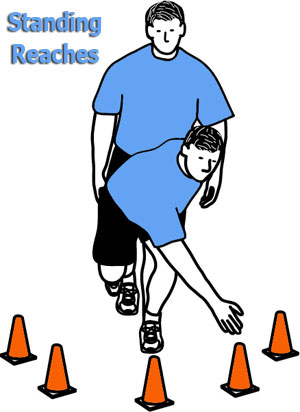Balance Training Drills for Soccer Players
The goal of soccer training is improved performance, injury prevention, soccer skills and tactics. Improved performance should never come at the cost of an injured player. Goal #1 is injury prevention in a soccer conditioning program. Goal #2 is to improve performance.
By and large we know balance has an important affect on life. Without
balance it would impossible to stand. Traditionally we think of balance
in terms of young kids walking a narrow balance beam or balancing on one
leg. But it is important to consider balance as a dynamic process with
each step, cut, or landing movement requiring its own element of
balance. For the sake of this article we will examine balance from two
general standpoints: First, balance as it relates to movement. Second,
how to do it.
Frequently balance training is seen as a process primarily for younger
kids. But I beg to differ. Balance training can be especially important,
from an injury reduction standpoint for all ages. A recent showed that
balance training could lower ACL injury risk during sporting maneuvers.
(1)
Balance can be improved. A study in 2009 showed that a neuromuscular
training program can increase balance and proprioceptive capabilities.
(2) Without boring you with a longer more exhaustive explanation of what
balance is letís get to some fun exercises you can do to increase
balance.
Before you get started everyone will have their own threshold of
balance. What is easy for Jim could be tough for John. When choosing the
exercises below, pair players that have similar balance ability. If you
are working by yourself skip the first two. Also, this is by no means an
exhaustive live of all balance training exercises available. Just a few
to get you started.
Slap the hands
You know this one. One player has his/her hands on top and the other
underneath. Palms are touching each other. The player on the top cannot
move his/her hands till the one of the bottom moves. The objective is to
have the player whose hands are on the bottom quickly slap the top of
the hands of the other player. To build balance players should do this
standing on one leg. Make sure it is done standing on both the left leg
and right. First player to 6 slaps loses. (BE NICE!) (Consult with a
doctor before doing any such exercises. I am kidding.)
Push the hands
You know this one too. Players stand facing each with two hands in front
at chest height. Both players are to push their hands forward onto the
other playerís hands trying to get the other to take a step. To mix it
up when both people are pushing the hands forward one will quickly move
his/her hands out of the expected path trying to catch the other
unexpectedly, causing the opponent to lose balance. The objective is to
the get the other to take a step. You can only do this by making contact
with the other personís hands and pushing them over. Or, as mentioned
above, causing the other person to lose balance by quickly move your
hands out of the way. I repeat, you can only touch hands. First one to 6
steps loses. Make sure you train both legs.
Standing balance progression
Stand on one leg and balance-For most this will be too easy. Try it out
anyways to test the level of balance. Start with 30 second stands.
Level two-Stand on one leg with your eyes closed. This gets more
difficult. Start with 30
 second
stands.
second
stands.
Level three-Standing reaches. Place small cones (or soccer balls) in
front of you. Put the cones far enough out to challenge the balance but
not too far where it is impossible to reach. Standing on one foot reach
out in a controlled speed and touch each cone. Do this on both legs for
3 sets each.
If you wish set up the above exercises in stations. Have one group of
athletes standing on one leg with the eyes closed, another group working
standing reaches, while another group does the pushing hands. Ask
yourself if your athletes can do the exercises mentioned. Feel free to
choose your own balance exercises. If the exercises mentioned donít
challenge your balance harder one. You can add movement like sliding to
the side then having all athletes stop on the whistle. The caveat is
they must stop on one leg without touching the other to the ground. Push
your balance creative thinking to new levels to reduce the injury rate
of your athletes and improve balance.
Bibliography
JL, C. (2010). Training Affects Knee Kinematics and Kinetics in Cutting
Maneuvers in Sport. Med SCi Sports Exerc.
TC, m. (2009). Balance improvements in female high school basketball
players after a 6-week neuromuscular-training program. J Sport Rehabil.
, 465-81.
